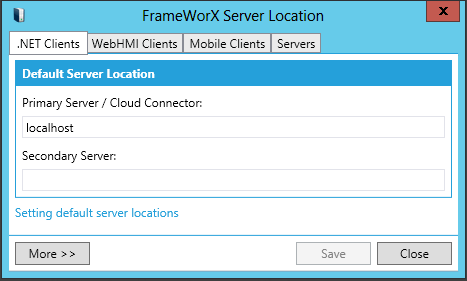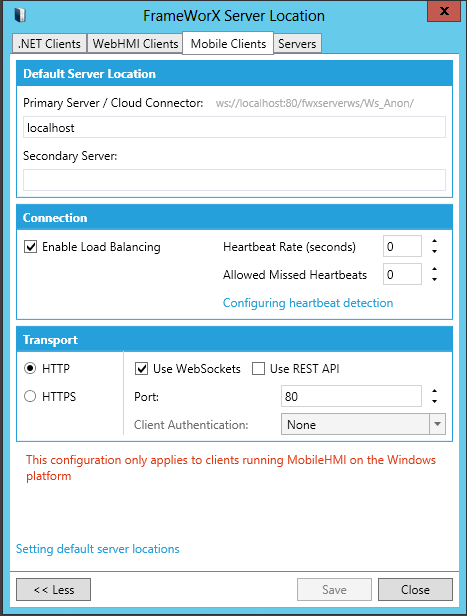
To Open the FrameWorX Server Location Settings:
Open the Workbench, then click on the Tools ribbon.
Click on the FrameWorX Server Location button, shown below, in the Tools section of the Tools ribbon.
FrameWorX Server Location Button

The FrameWorX Server Location window will appear within the Workbench.
FrameWorX Server Location Window

The window allows you to configure settings for your default FrameWorX Server location with use by the following clients:
Default Server Location - .NET Clients

In the Default Server Location section, in the Primary Server/Cloud Connector text field, type the node name of the FrameWorX Server. Enter localhost to specify the local computer.
If you wish to enable redundancy, specify the Secondary FrameWorX Server location in the Secondary Server text field.. The secondary server will take over if the primary server becomes unavailable. (Leave this field empty to switch off redundancy.)
Click the More button if you wish to set additional properties. The remainder of the window will look like the following image.
More Options Within the .NET Clients Tab Properties

If you specified a Secondary default server same, for the optimal use of resources, you can put a check mark in the Enable Load Balancing check box. For a complete description of important load balancing information, refer to the Platform Services Configuration topic.
Also, if you specified a Secondary default server name, you can put a check mark in the Auto Switch Back to Primary check box if you want the clients to automatically switch back to the primary server when the primary server becomes available again. If you leave this option unchecked, it will not automatically switch back to the primary server. Instead, you will have to switch it back manually when the server is available. (For instructions for manually switching over, refer to the Monitoring Redundancy Using MonitorWorX topic.) Enter a Heartbeat Rate (in seconds) in the text entry field. Enter a number of Allowed Missed Heartbeats (the number of signals lost in a row that should be considered as a connection failure) in the text entry field.
In the Transport section, select the Transport Protocol (choose either HTTP, HTTPS, WS HTTP or NET.TCP). Note that a proper Port Number is selected for each protocol. If you change the port number here, you must also change it for the FrameWorX Server. This must be done manually.
If HTTP or HTTPS is selected, you can decide whether you will Use WebSockets by clicking on the checkbox.
You can decide whether you will Use REST API by clicking on the check box.
You can decide whether to 'Use Integrated Windows Authentication' for your selected Transport Protocol by clicking on the check box. Note that selection of the HTTPS transport protocol will enforce the use of integrated Windows Authentication.
You can decide to 'Use Client Certificate (Subject Name or Thumbprint)', by clicking on the check box. If selected, you can enter the Subject Name or Thumbprint information in the text field below the check box.
In the License Grace Period section, you can decide if you wish to Enable Grace Period. If selected, you can then set a Duration (in minutes) in the nearby text entry field.
Click Save when you are done.
Restart all client applications for these settings to take effect.
Default Server Location - WebHMI Clients

In the Default Server Location section, in the Primary Server/Cloud Connector text field, type the node name of the FrameWorX Server. Enter localhost to specify the local computer.
If you wish to enable redundancy, specify the Secondary FrameWorX Server location in the Secondary Server text field. The secondary server will take over if the primary server becomes unavailable. (Leave this field empty to switch off redundancy.)
Click the More button if you wish to set additional properties. The remainder of the window will look like the following image.
More Options Within the WebHMI Clients Tab Properties

If you specified a Secondary default server same, for the optimal use of resources, you can put a check mark in the Enable Load Balancing check box. For a complete description of important load balancing information, refer to the Platform Services Configuration topic.
Also, if you specified a Secondary default server name, you can put a check mark in the Auto Switch Back to Primary check box if you want the clients to automatically switch back to the primary server when the primary server becomes available again. If you leave this option unchecked, it will not automatically switch back to the primary server. Instead, you will have to switch it back manually when the server is available. (For instructions for manually switching over, refer to the Monitoring Redundancy Using MonitorWorX topic.) Note that Hearbeat parameters are common with .NET Clients.
In the Transport section, select the Transport Protocol (choose either HTTP, HTTPS, WS HTTP or NET.TCP). Note that a proper Port Number is selected for each protocol. If you change the port number here, you must also change it for the FrameWorX Server. This must be done manually.
If HTTP or HTTPS is selected, you can decide whether you will Use WebSockets by clicking on the checkbox.
You can decide whether you will Use REST API by clicking on the check box.
You can decide whether to 'Use Integrated Windows Authentication' for your selected Transport Protocol by clicking on the check box. Note that selection of the HTTP transport protocol for WebHMI Clients will restrict the use of integrated Windows Authentication and also that the selection of the HTTPS transport protocol will enforce the use of integrated Windows Authentication.
You can decide to 'Use Client Certificate (common with .NET Clients)', by clicking on the check box. Note that if you had already selected the HTTP or HTTPS transport protocols, clicking this box will change the selected transport protocol to WS HTTP. The text entry field beneath the check box will remain greyed out for any transport protocol selection.
Click Save when you are done.
Restart all client applications for these settings to take effect.
Default Server Location - Mobile Clients

In the Default Server Location section, in the Primary Server/Cloud Connector text field, type the node name of the FrameWorX Server. Enter localhost to specify the local computer.
If you wish to enable redundancy, specify the Secondary FrameWorX Server location in the Secondary Server text field. The secondary server will take over if the primary server becomes unavailable. (Leave this field empty to switch off redundancy.)
Click the More button if you wish to set additional properties. The remainder of the window will look like the following image.
More Options Within the Mobile Clients Tab Properties

If you specified a Secondary default server same, for the optimal use of resources, you can put a check mark in the Enable Load Balancing check box. For a complete description of important load balancing information, refer to the Platform Services Configuration topic. Enter a Heartbeat Rate (in seconds) in the text entry field. Enter a number of Allowed Missed Heartbeats (the number of signals lost in a row that should be considered as a connection failure) in the text entry field.
In the Transport section, select the Transport Protocol (choose either HTTP or HTTPS). Note that a proper Port Number is selected for each protocol. If you change the port number here, you must also change it for the FrameWorX Server. This must be done manually.
If HTTP or HTTPS is selected, you can decide whether you will Use WebSockets by clicking on the checkbox.
You can decide whether you will Use REST API by clicking on the check box.
Click Save when you are done.
Restart all client applications for these settings to take effect. Note that this configuration only applies to Microsoft Windows 8 and Windows Phone 8 clients.
Default Server Location - Servers

In the Default Server Location section, in the Primary Server/Cloud Connector text field, type the node name of the FrameWorX Server. Enter localhost to specify the local computer.
If you wish to enable redundancy, specify the Secondary FrameWorX Server location in the Secondary Server text field.. The secondary server will take over if the primary server becomes unavailable. (Leave this field empty to switch off redundancy.)
Click the More button if you wish to set additional properties. The remainder of the window will look like the following image.
More Options Within the Server Tab Properties

If you specified a Secondary default server same, for the optimal use of resources, you can put a check mark in the Enable Load Balancing check box. For a complete description of important load balancing information, refer to the Platform Services Configuration topic.
Also, if you specified a Secondary default server name, you can put a check mark in the Auto Switch Back to Primary check box if you want the clients to automatically switch back to the primary server when the primary server becomes available again. If you leave this option unchecked, it will not automatically switch back to the primary server. Instead, you will have to switch it back manually when the server is available. (For instructions for manually switching over, refer to the Monitoring Redundancy Using MonitorWorX topic.) Enter a Heartbeat Rate (in seconds) in the text entry field. Enter a number of Allowed Missed Heartbeats (the number of signals lost in a row that should be considered as a connection failure) in the text entry field.
In the Transport section, select the Transport Protocol (choose either HTTP, HTTPS, WS HTTP or NET.TCP). Note that a proper Port Number is selected for each protocol. If you change the port number here, you must also change it for the FrameWorX Server. This must be done manually.
If HTTP or HTTPS is selected, you can decide whether you will Use WebSockets by clicking on the checkbox.
You can decide whether you will Use REST API by clicking on the check box.
You can decide whether to 'Use Integrated Windows Authentication' for your selected Transport Protocol by clicking on the check box. Note that selection of the HTTPS transport protocol will enforce the use of integrated Windows Authentication.
You can decide to 'Use Client Certificate (Subject Name or Thumbprint)', by clicking on the check box. If selected, you can enter the Subject Name or Thumbprint information in the text field below the check box.
In the License Grace Period section, you can decide if you wish to Enable Grace Period. If selected, you can then set a Duration (in minutes) in the nearby text entry field.
Click Save when you are done.
Restart all client applications for these settings to take effect.
See Also: